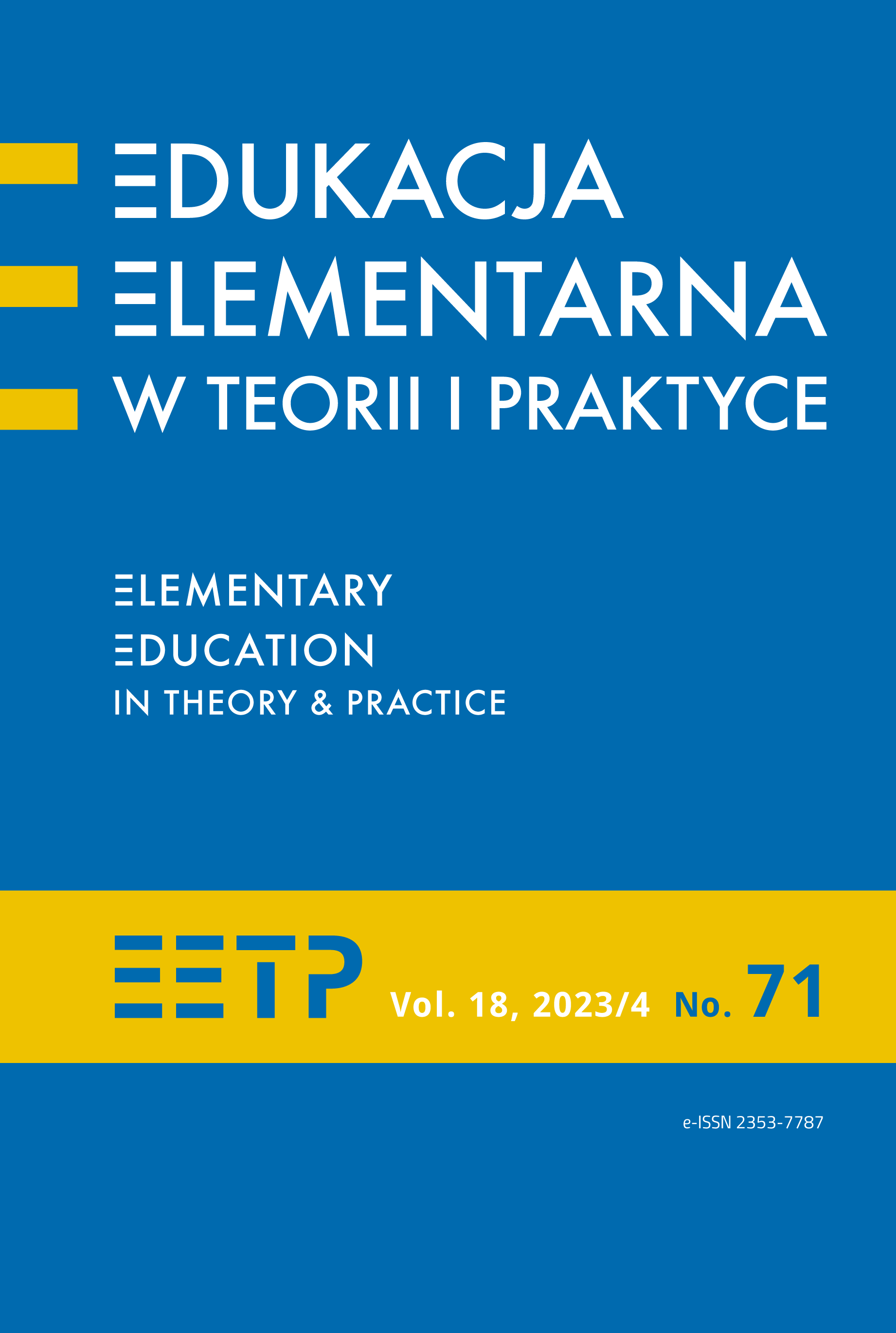Postapokalipsa w Krótkich Gatkach, czyli jak przygotować dzieci na (każdą) katastrofę
Abstrakt
Literatura dystopijna, również w wydaniu obrazkowym, od lat stanowi stały podgatunek kultury popularnej. O ile jednak na rynku nie brakuje dystopijnych, głównie postapokaliptycznych, utworów dla dorosłych czy starszej młodzieży (young adults), o wiele rzadziej obierają tę konwencję autorzy literatury kierowanej jednoznacznie do młodszego, dziecięcego czytelnika. Jednym z niewielu wyjątków jest autorska, ośmioczęściowa seria komiksowa Marcina Podolca Bajka na końcu świata opublikowana w latach 2017–2023 przez Kulturę Gniewu. Jej bohaterkami są dziewczynka Wiktoria i jej psia przyjaciółka Bajka, które wędrują przez „świat po wielkim wybuchu”, czyli wymarłe i zniszczone krainy pełne wszelkiego rodzaju anomalii w zakresie fauny, flory oraz zjawisk fizycznych. Na poziomie fabularnym wizja przedstawiona w kolejnych częściach serii czerpie pełnymi garściami z posępnego repertuaru postapokaliptycznych wizji znanych z literatury czy filmów dla dorosłych odbiorców. W artykule podjęta zostaje próba prześledzenia w jaki sposób autor scenariusza i rysunków opowiada przygody Wiktorii i Bajki w tym zniszczonym i budzącym grozę świecie w złagodzonej formie dopasowanej do percepcji dziecięcego odbiorcy.
Bibliografia
Błaszkowska, M. (2019). Porządki nierzeczywistości. Koherencja światów przedstawionych w polskiej fantastyce współczesnej. [Rozprawa doktorska napisana pod kierunkiem prof. dr hab. Anny Łebkowskiej]. Uniwersytet Jagielloński. https://ruj.uj.edu.pl/xmlui/bitstream/handle/item/269514/blaszkowska_porzadki_nierzeczywistosci_koherencja_swiatow_2019.pdf?sequence=1&isAllowed=y
Chmielewski, D. i Podolec, M. (2014). Podgląd. Kultura Gniewu.
Gąska, P. (2016). Historia rozwoju konwencji postapokaliptycznej jako odbicie lęków kultury zachodniej. Annales Universitatis Mariae Curie-Sklodowska, sectio FF – Philologia, 34(2), 13–32. http://cejsh.icm.edu.pl/cejsh/element/bwmeta1.element.ojs-doi-10_17951_ff_2016_34_2_13/c/3783-3391.pdf
Genette, G. (2002). Seuils. Editions Du Seuil.
Grzymała-Moszczyńska, H. i Różańska-Mglej, M. (2019). Komiks jako sposób radzenia sobie z traumą uchodźczą. Relacje Międzykulturowe = Intercultural Relations, 1(5), 169–185. https://ruj.uj.edu.pl/xmlui/bitstream/handle/item/77000/grzymala-moszczynska_rozanska-mglej_komiks_jako_sposob_radzenia_sobie_z_trauma_2019.pdf
Kołodziejczyk, M. i Podolec, M. (2016). Morze po kolana. Wielka Litera, Kultura Gniewu.
Kultura Gniewu. (b.d.). Krótkie Gatki. Kultura Gniewu. https://kultura.com.pl/15-krotkie-gatki
Mazepa-Domagała, B. (2011). Upodobania obrazowe dzieci w wieku przedczytelniczym
w zakresie ilustracji książkowej. Wydawnictwo Uniwersytetu Śląskiego.
McCloud, S. (2021). Zrozumieć komiks (M. Błażejczyk, tłum.). Kultura Gniewu.
Nijakowski, L. (2011). Popularne postapokalipsy późnej nowoczesności. W: P. Kowalski (red.), Mit, prawda, imaginacja (s. 243–269). Wydawnictwo Uniwersytetu Wrocławskiego. https://wuwr.pl/cac/article/view/842/814
Pablopavo [Sołtys, P.], Flint, M. i Podolec, M. (2016). Dym. Wywiad graficzny. Kultura Gniewu.
Podolec, M. (2013). Fugazi Music Club. Kultura Gniewu.
Podolec, M. (2017a). Opuszczony dom. [Seria „Bajka na końcu świata”, 2]. Kultura Gniewu.
Podolec, M. (2017b). Ostatni ogród. [Seria „Bajka na końcu świata”, 1]. Kultura Gniewu.
Podolec, M. (2018). Ożywczy deszcz. [Seria „Bajka na końcu świata”, 3]. Kultura Gniewu.
Podolec, M. (2019). Opowieść gołębia. [Seria „Bajka na końcu świata”, 4]. Kultura Gniewu.
Podolec, M. (2020). Odległe krainy. [Seria „Bajka na końcu świata”, 5]. Kultura Gniewu.
Podolec, M. (2021a). Bajka i jej gang. Kultura Gniewu.
Podolec, M. (2021b). Operacja Trufla. [Seria „Bajka na końcu świata”, 6]. Kultura Gniewu.
Podolec, M. (2022). Ognie na niebie. [Seria „Bajka na końcu świata”, 7]. Kultura Gniewu.
Podolec, M. (2023). Otwarte drzwi. [Seria „Bajka na końcu świata”, 8]. Kultura Gniewu.
Popek, S. (1999). Barwy i psychika. Percepcja, ekspresja, projekcja. Wydawnictwo Uniwersytetu Marii Curie-Skłodowskiej.
Shavit, Z. (1986). Poetics of children’s literature, The University of Georgia Press. http://humanities1.tau.ac.il/segel/zshavit/files/2014/03/poetics-of-childrens-literature.pdf
Szyłak, J. (2017). Jak czytać komiksy i właściwie po co? Jednak Książki. Gdańskie Czasopismo Humanistyczne, 8, 149–168. http://cejsh.icm.edu.pl/cejsh/element/bwmeta1.element.desklight-2fa68cf9-1fa0-425c-809e-ec6011c6a786/c/9_Szylak.pdf
Tałuć, K. (2017). Komiks polski dla młodego odbiorcy – tendencje, tematy, wydawcy. W: K. Tałuć (red.), Literatura dla dzieci i młodzieży. T. 5 (s. 254–286). Wydawnictwo Uniwersytetu Śląskiego. https://rebus.us.edu.pl/bitstream/20.500.12128/11505/1/Taluc_Komiks_polski_dla_mlodego_odbiorcy_tendencje_tematy_wydawcy.pdf
Wierel, K. (2017). Czarny horyzont, czyli śmierć Zachodu. Kultura postapokaliptyczna jako alternatywna wizja przyszłości. W: A. Kisielewska, A. Kisielewski i M. Kostaszuk-Romanowska (red.), Przyszłość kultury: od diagnozy do prognozy (s. 47–68). Wydawnictwo Prymat. https://repozytorium.uwb.edu.pl/jspui/bitstream/11320/10819/1/K_Wierel_Czarny_horyzont_czyli_smierc_Zachodu.pdf
Wierel, K. (2019). Księga w nie-ludzkim świecie. Motyw Księgi w postapokaliptycznych przekazach, literackich i filmowych przełomu XX i XXI wieku. Wydawnictwo Uniwersytetu w Białymstoku. https://repozytorium.uwb.edu.pl/jspui/bitstream/11320/8856/1/K_Wierel_Ksiega_w_nie_ludzkim_swiecie.pdf
Witkowski, P. (2020, marzec). Apokalipsa instant. Rozmowa z Lechem M. Nijakowskim, Dwutygodnik, 278. https://www.dwutygodnik.com/artykul/8815-apokalipsa-instant.html?print=1
Zabawa, K. (2013). Rozpoczęta opowieść. Polska literatura dziecięca po 1989 roku wobec kultury współczesnej. Akademia Ignatianum – Wydawnictwo WAM.
Zając, M. (2000). Promocja książki dziecięcej. Podręcznik akademicki. Wydawnictwo SBP.
Zeugner, G. (1965). Barwa i człowiek (J. Rogaczewski, tłum.). Arkady.
Copyright (c) 2023 Edukacja Elementarna w Teorii i Praktyce

Utwór dostępny jest na licencji Creative Commons Uznanie autorstwa – Bez utworów zależnych 4.0 Międzynarodowe.
1. Autor zgłaszając swój artykuł oświadcza, że jest Autorem artykułu (zwanego dalej Utworem) i:
- przysługują mu wyłączne i nieograniczone prawa autorskie do Utworu,
- jest uprawniony/a do rozporządzania prawami autorskimi do Utworu.
Oświadcza, że nie narusza praw autorskich osób trzecich i praw prawnych.
Oświadcza, że nie występuje żaden konflikt interesów.
2. Udziela Uniwersytetowi Ignatianum w Krakowie nieodpłatnej, niewyłącznej, nieograniczonej terytorialnie licencji do korzystania z Utworu na następujących polach eksploatacji:
- utrwalania utworu w formie papierowej, a także na nośniku cyfrowym lub magnetycznym;
- zwielokrotnienia utworu dowolną techniką, bez ograniczenia ilości wydań i liczby egzemplarzy;
- rozpowszechniania utworu i jego zwielokrotnionych egzemplarzy na jakimkolwiek nośniku, w tym wprowadzenia do obrotu, sprzedaży, użyczenia, najmu;
- wprowadzenia utworu do pamięci komputera;
- rozpowszechniania utworu w sieciach informatycznych, w tym w sieci Internet;
- publicznego wykonania, wystawienia, wyświetlenia, odtworzenia oraz nadawania i reemitowania, a także publicznego udostępniania utworu w taki sposób, aby każdy mógł mieć do niego dostęp w miejscu i czasie przez siebie wybranym;
- w zakresie praw zależnych do Utworu, obejmujących w szczególności prawo do dokonania koniecznych zmian w Utworze, wynikających z opracowania redakcyjnego i metodycznego, a także do dokonania tłumaczenia Utworu na języki obce.
Udzielenie licencji następuje z chwilą przekazania Utworu na rzecz Uniwersytetowi Ignatianum w Krakowie. Uniwersytet Ignatianum w Krakowie jest uprawniony do udzielania dalszych sublicencji do Utworu, w zakresie udzielonego prawa. Licencja jest ograniczona czasowo i zostaje udzielona na okres 15 lat, licząc od daty jej udzielenia.
Wyraża się zgodę i zachęca autorów do publikacji ich tekstu w Internecie (np. w repozytorium instytucji lub na jej stronie internetowej) przed lub podczas procesu składania tekstu jako, że może to prowadzić do korzystnych wymian oraz wcześniejszego i większego cytowania opublikowanego tekstu (Patrz The Effect of Open Access). Zalecamy wykorzystanie dowolnego portalu stowarzyszeń badawczych z niżej wymienionych:




